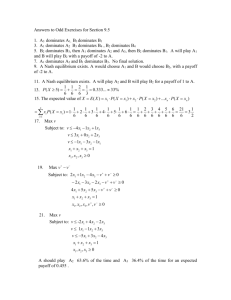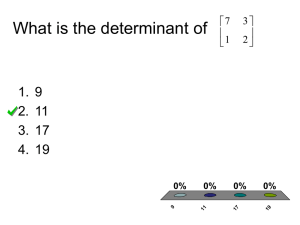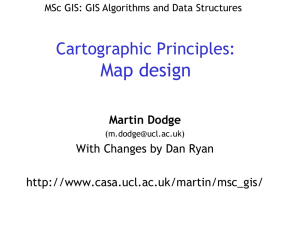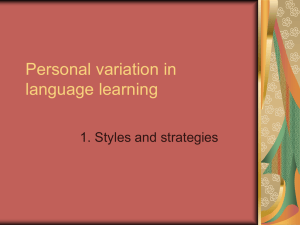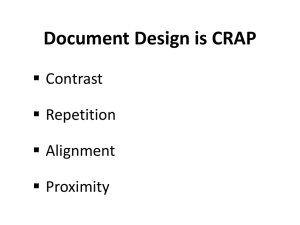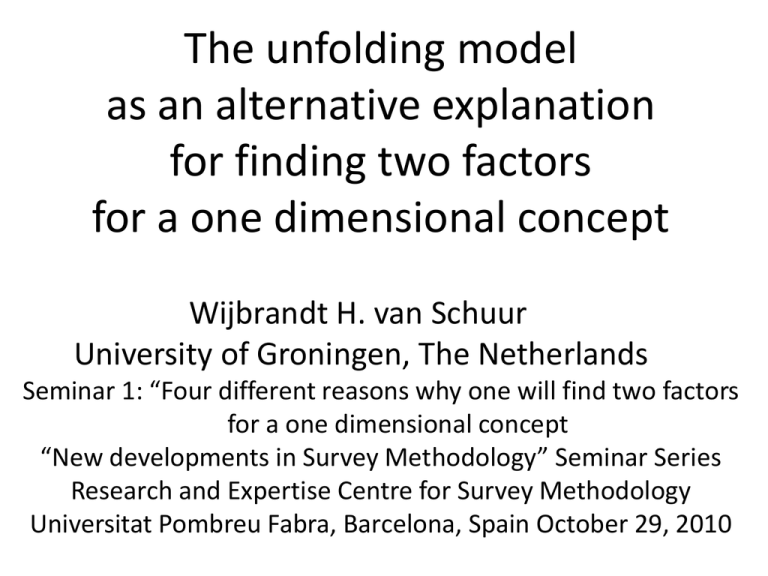
The unfolding model
as an alternative explanation
for finding two factors
for a one dimensional concept
Wijbrandt H. van Schuur
University of Groningen, The Netherlands
Seminar 1: “Four different reasons why one will find two factors
for a one dimensional concept
“New developments in Survey Methodology” Seminar Series
Research and Expertise Centre for Survey Methodology
Universitat Pombreu Fabra, Barcelona, Spain October 29, 2010
Dominance
In the dominance model: order of questions is represented
in terms of less to more ‘popular’ responses
Cumulative scale: IF the ‘positive’ or ‘high’ answer is given
to an impopular question, THEN the ‘positive’ or ‘high’
answer is given to all more popular questions
Examples given in Intro to seminar: “The higher level
of competence always requires the lower competences
but with some extra capability”.
Survey questions
Q.1a Are you taller than 1.70m?
Q.1b Are you taller than 1.80m?
yes/no
Q.2a
Q.2b
2+2 = ?
15.72* √0.49 = ?
correct/incorrect
Q.3a
Q.3b
Believe in heaven?
Believe in hell
Q.4a
Q.4b
Do you own a cd-player?
Do you own a dish washer?
Agree/disagree
yes/no
Data Matrix
ABCDE
00 00 0
10 00 0
11 00 0
11 10 0
11 11 0
11 11 1
Correlation Matrix
A
B
C
D
A 1.00 0.63 0.45 0.32
B
0.63 1.00 0.71 0.50
C
0.45 0.71 1.00 0.71
D
0.32 0.50 0.71 1.00
E
0.20 0.32 0.45 0.63
E
0.20
0.32
0.45
0.63
1.00
Eigenvalues: 3.0, 1.0, 0.5, 0.3, 0.2
Two large ones (Principal Components Analysis, PCA)
Example 2
Component Matrix
Factor 1
2
A .66
.60
B .83
C .88
D .83
E .66
-.60
- : factor loading < .40
Rotated Component Matrix
Factor 1
2
A
.89
B
.85
C
.62
.62
D
.85
E
.89
-
Polytomous items
A
1
2
2
3
3
4
5
5
5
5
5
5
5
B
1
1
2
2
3
3
4
4
4
5
5
5
5
C
1
1
1
2
2
3
3
4
4
4
5
5
5
D
1
1
1
1
2
2
2
2
3
3
4
5
5
E
1
1
1
1
1
1
2
2
2
2
2
4
5
F
1
1
1
1
1
1
1
1
1
1
1
2
2
weight
10
50
20
20
10
30
320
80
30
200
200
20
10
Correlations and factor loadings
A
B
C
D
E
F
A
1.00
0.89
0.75
0.55
0.63
0.07
B
0.89
1.00
0.90
0.80
0.64
0.14
C
0.75
0.90
1.00
0.92
0.60
0.22
D
0.55
0.80
0.92
1.00
0.64
0.42
E
0.63
0.64
0.60
0.64
1.00
0.77
Eigenvalues: 4.1, 1.2, 0.51, 0.06, 0.04, 0.02
A
B
C
D
E
F
Unrotated
Factor 1
2
0.83
-0.35
0.93
-0.32
0.93
0.89
0.83
0.45
0.45
0.88
VARIMAX rotated
Factor 1
2
0.90
0.97
0.93
0.79
0.41
0.54
0.79
0.99
F
0.07
0.14
0.22
0.42
0.77
1.00
Dominance model
A
B
C
D
E
─┴──┬──┴──┬───┴───┴─┬──┴──
low S1
S2
S3
high
Dominance:
item E dominates item D, C, B, and A
Subject S3 dominates subject S2 and subject S1
Item E dominates Subjects S1, S2, and S3,
Subject S2 dominates items B and A, and
Subject S1 dominates item A
Subject dominates item: positive or high response
Item dominates subject: negative or low response
Proximity questions
Survey questions
Q.1a
Do you like tea without sugar?
yes/no
Q.1b
Do you like tea with 1 lump of sugar?
Q.1c
Do you like tea with 2 lumps of sugar?
Q.2a
Q.2b
Q.2c
Would you vote for leftist party?
Would you vote for centrist party?
Would you vote for rightist party?
yes/no
Proximity model
A
B
C
D
E
─┴──┬──┴────┬─┴───┴─┬──┴──
low S1
S2
S3
high
Proximity:
Subject S1 is close to (agrees with) items A and B
Subject S2 is close to (agrees with) items B, C, and D
Subject S3 is close to (agrees with) items D and E
Positive response: agrees (is close)
Negative response: disagrees (is distant)
Dichotomous dataset
S1
S2
S3
A
1
0
0
B
1
1
0
C
0
1
0
D
0
1
1
110000
011000
001100
000110
000011
111000
011100
001110
000111
pick 2/n
pick 3/n
E
0
0
1
100000
110000
011100
011110
000111
000010
pick any/n
Proximity dataset (hypothetical)
Person
1
2
3
4
5
6
7
8
9
10
11
A
4
4
5
5
4
4
3
3
2
2
1
B
3
4
4
5
5
4
4
3
3
2
2
C
3
3
4
4
5
5
4
4
3
3
2
D
2
3
3
4
4
5
5
4
4
3
3
E
2
2
3
3
4
4
5
5
4
4
3
F
1
2
2
3
3
4
4
5
5
4
4
Correlation Matrix
A
B
C
D
E
F
A
1.00
.81
.63
.04
-.31
-.63
B
C
D
.81 .63 .04
1.00 .75 .44
.75 1.00 .65
.44 .65 1.00
-.03 .44 .75
-.31 .04 .63
E
-.31
-.03
.44
.75
1.00
.81
F
-.63
-.31
.04
.63
.81
1.00
Eigenvalues: 2.83, 2.68, 0.27, 0.09, 0.08, 0.06
Factor loadings
Unrotated
Factor 1
A
B
.68
C
.90
D
.90
E
.68
F
-
2
-.89
-.67
.67
.89
Rotated (VARIMAX)
Factor
1
2
A
.90 B
.95 C
.86 .41
D
.41 .86
E
.95
F
.90
Electoral compass
36 statements with 5 response categories:
completely agree (5) – tend to agree (4) – neutral (3)
– tend to disagree (2) – completely disagree (1)
Respondents are asked to give their opinion.
These are then compared with the opinions of
Obama, Clinton, Richardson, Edwards, McCain,
Huckabee, Romney and Thomson
Electoral advice: vote for candidate
with whom you agree the most
More survey questions
People should have a background check and obtain a license before they can buy a gun
Same sex marriages should be made legal
US law should obligate all companies to provide health care insurances for their workers
The new president should begin to bring home all US troops from Iraq immediately
The tax cuts for people with a higher income should be reversed
All illegal immigrants without criminal record should be given the right to stay in the US legally
The US should reduce its financial contribution to the UN
An additional carbon tax on fuel will effectively reduce carbon emission
The US had every right to invade Iraq
The death penalty helps deter crime
Better teachers should be paid higher wages than their colleagues
For each crime there should be a fixed minimum sentence
Iraq is just one front in a broader fight against Islamic terrorism
Abortion should be made completely illegal
Creationism should be taught in science classes in school
The effects of global warming are grossly exaggerated
Some form of torture is acceptable if it can prevent terrorist attacks
The US should never sign international treaties on climate change that limit economic growth
Factor loadings (PCA)
Unrotated
Rotated (VARIMAX)
Factor
1
2
Factor
1
2
Obama
-.89 .81
Clinton
-.72 .51
.87
Richardson
-.53 .48
Edwards
-.74 .49
.87
McCain
.68 .48
.82
Huckabee
.78
.76
Romney
.73 .41
.81
Thomson
.86
.81 -.40
(eigenvalues: 4.4, 1.2, 0.99, 0.45, 0.36, 0.29, 0.17, 0.16)
Localism- Cosmopolitanism
How interested are you in news about
A
The world
B
Europe
C
Your country
D
Your province
E
Your local community
1: not interested; 4: neutral; 7: very interested
Correlation matrix / Loadings
A
B
C
A (World)
1.00 .76
.61
B (Europe)
.76 1.00
.58
C (country)
.61 .58 1.00
D (province) .27 .48
.44
E (community) .20 .30
.47
Eigenvalues: 2.9, 1.1, 0.5, 0.3, 0.2
Unrotated
Factor
A World
B Europe
C country
D province
E community
1
.76
.84
.82
.72
.65
2
-.55
-.35
.51
.64
D
.27
.48
.44
1.00
.64
E
.20
.30
.47
.64
1.00
Rotated (VARIMAX)
Factor 1
2
.94
.87
.71
.43
.85
.91
WARNING:
Any two (randomly chosen) cumulative scales joined
together form an artificial proximity (unfolding) scale
Impopular – popular
popular – impopular
A B
C
D
E
F
G
H
1 1
1
1
0
0
0
0
0 1
1
1
1
0
0
0
0 0
1
1
1
1
0
0
0 0
0
1
1
1
1
0
0 0
0
0
1
1
1
1
Joined together, this looks like a pick 4/8 unfolding dataset
Lithmus test for unfolding analysis
The negative response must be ambiguous:
It can be given for two opposite reasons:
the respondent is represented either too much
to the left of the item,
or the respondent is represented too much
to the right of the item
(Why not one lump: either no sugar, or more than one;
Why not vote for center party: either more to the left
or more to the right)
See Van Schuur & Kiers (1994). Why factor analysis
is the incorrect model for analyzing bipolar concepts
and what model to use instead.
Applied Psychological Measurement, 18, 97-110.
Item-Response Theory
Does not rely on correlations
(assumption: all items have the same distribution)
It uses the fact that items are not meant
to be replications of each other,
but they have their own characteristics
Extensive software to apply to the dominance
model (Rasch model, Mokken model) and the
proximity or unfolding model (GGUM, MUDFOLD)
THANK YOU
THE END
h.van.schuur@rug.nl



